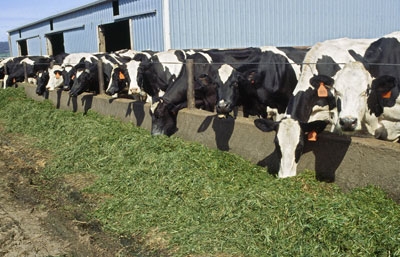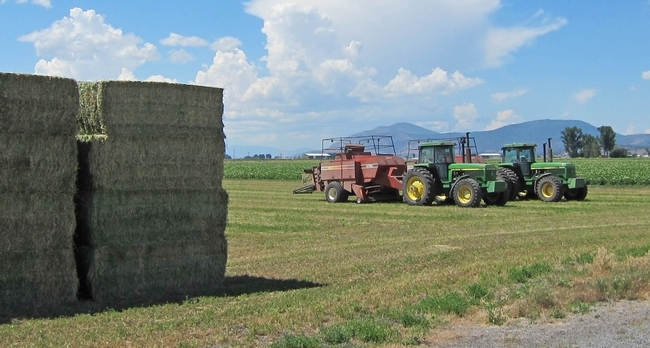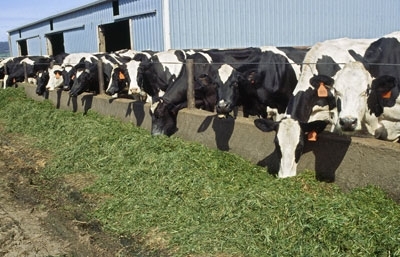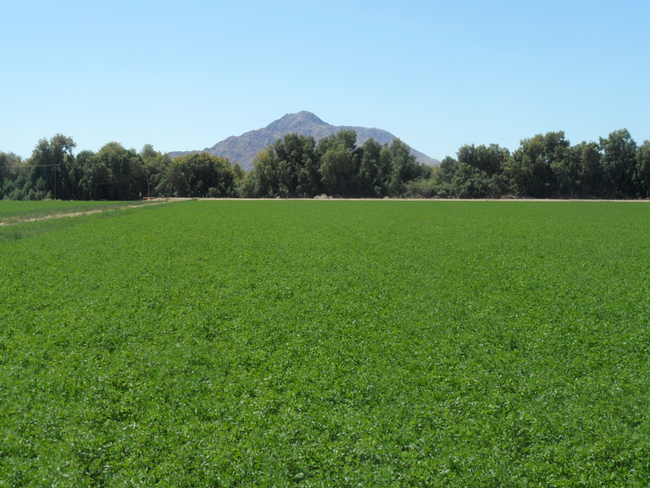Posts Tagged: alfalfa
California farmers rely on overseas markets to survive
California is a massive, food-making machine, providing America with two-thirds of its fruits and nuts, while becoming increasingly export driven, reported Heesun Wee on CNBC.
“The overseas market is extremely important,” said Jesús Ramos, a Tulare County citrus farmer. “That dictates whether you can keep a crop going or not.”
Another key to keeping crops going is the state's water situation. After four years of drought, Californians are hoping the predicted El Niño rains will live up to the forecast.
Wee interviewed UC Agriculture and Natural Resources alfalfa expert Daniel Putnam, a UC ANR Cooperative Extension specialist based at UC Davis. He said U.S. alfalfa hay exports to Asia and the Middle East have climbed in recent years. China's imports have risen from almost nothing in the mid-2000s to roughly 1 million metric tons forecast for 2015.
A University of Arizona water resource expert, Robert Glennon, told the reporter he was surprised to learn that 2 million tons of Western alfalfa hay, which required 100 billion gallons of water to produce, was shipped overseas.
“When I found out we were shipping bales of hay across the world, you could have knocked me over with a feather,” Glennon said.
One of the export drivers is cheap shipping to Asia in containers that might otherwise make the return trip across the Pacific Ocean unfilled. Putnam estimates shipping hay from the Imperial Valley to Tulare County can run $60 to $70 per ton. But transporting the hay from Long Beach to a port in Asia costs $25 to $45 a ton.
UC ANR clarifies drought misconceptions
In two recent broadcast media stories, UC Agriculture and Natural Resources experts were able to provide accurate information about the water use on commodities that have been criticized for water consumption during the drought.
The director of UC ANR's Agricultural Issues Center, Daniel Sumner, was one of three guests on the one-hour talk radio program Your Call, which was broadcast on KALW, Local Public Radio in San Francisco. The topic - How would reducing our intake of meat and dairy affect the drought? - was prompted by off-the-cuff comments made by Gov. Jerry Brown in June. Answering the question, "Is part of the drought strategy to reduce meat consumption?" Brown replied, "If you ask me, I think you should be eating veggie burgers."
On the Your Call show, Sumner explained that beef consumption has little impact on the California drought.
"I do want to make clear, when it comes to water embedded in any product, it depends where the water is from," Sumner said. "We feed cattle in California with grain from the Midwest."
Dairy production is another issue. "Dairy cows are fed lots of grain, soybeans and canola coming from Canada and the Midwest, but also silage and alfalfa, much of which is from California. California dairy is a drought water issue. Beef really isn't."
UC ANR Cooperative Extension specialist Dan Putnam appeared on the KTVU Evening News to discuss alfalfa water use with reporter Ken Wayne. Putnam said the drought has hurt the state's alfalfa industry.
"Statewide, it's been fairly devastating," Putnam said. "We're at the lowest acreage we've seen probably since the 1930s."
He also noted the importance of the crop, a key part of dairy cattle's diets.
"An average field of alfalfa produces approximately 2,400 gallons of milk per acre," Putnam said.
Drip irrigation in alfalfa cuts water use, but isn't for everybody
The drought is forcing farmers to reexamine the way they water their crops, but converting to drip irrigation in alfalfa is unlikely to be widely implemented, reported David Wagner on KPBS Radio News.
The drip irrigation system conserves water - almost by half, said farmer Jack Cato - but is expensive and requires regular maintenance. After six years, the drip system is yet to pay for itself.
"Drip irrigation is not the answer for everything," said Khaled Bali, irrigation advisor with UC Agriculture and Natural Resources (UC ANR). "I would not recommend switching every acre in the Imperial Valley to drip irrigation."
Cato added that new drip irrigation users face a steep learning curve.
"Whatever farm starts doing this, he needs to take baby steps," Cato said. "It's not something you learn overnight, or in a book. You have to study your fields daily."
For more on water use and alfalfa, see Why alfalfa is the best crop to have in the drought by Daniel Putnam, UC ANR Cooperative Extension specialist based at UC Davis, in the Alfalfa & Forage Blog.
Alfalfa hay price skyrockets
Good news for alfalfa growers is bad news for dairy producers. High demand for alfalfa hay and a small crop in the United States has resulted in a price hike of more than 50 percent, according to the Merced Sun-Star. In Merced, supreme alfalfa hay is pulling in $275 to $285 a ton.
"Alfalfa hay is a very important part of a lactating cow's diet, because cows need the fiber and the protein from alfalfa," Castillo was quoted.
Milk is in demand around the world, spurring the growth of dairies and creating a market for U.S. alfalfa abroad.
"We are selling a lot of alfalfa hay to Japan and China," Castillo said. "They have dairies there that have California technology."
Drought in some parts of the U.S. means there's less grass for grazing cattle. The grass has to be replaced with hay, putting more demand on the already stretched hay supply.

Alfalfa is an important part of a lactating cow's diet.
Biomass may help solve world energy problems
UC Cooperative Extension forage specialist Dan Putnam believes California farmers need to envision and implement biomass-based, highly productive food, fuel and energy production systems to meet the increasing demands of the growing world population.
Putnam's thoughts were written up by reporter Cary Blake and posted yesterday on the Western Farm Press website.
The article noted that one biomass crop showing potential in California is switchgrass, which is grown in other parts of the country for forage. Putnam has four switchgrass trials underway.
"The switchgrass yields, especially in the Central Valley, California trials, are quite impressive on good soils with irrigation," Putnam was quoted in the story. "Yields have reached 18 tons per acre — some of the highest switchgrass yields recorded in the nation."
The fact that switchgrass may not need water year round is another favorable attribute. The plant's deep root system enables it to survive in low water conditions.
"This is very encouraging, especially in California where water supplies are an ongoing concern," Putnam said.
Putnam urged farmers to cautiously investigate biomass to determine how it may fit into their diversification portfolio.
"The next few years should be an exciting ride for U.S. agriculture in terms of new opportunities in the energy sector," Blake wrote in closing.

Switchgrass is a possible biofuel crop.



